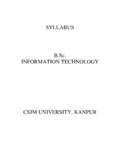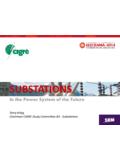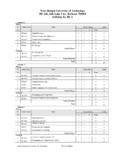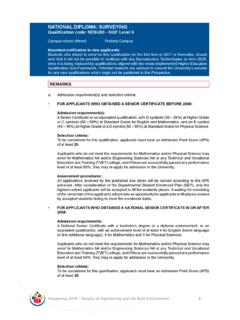Transcription of Mining company strategy evolution: an overview …
1 Mining company strategy EVOLUTION169 IntroductionBetween 2000 and 2012, the platinum group metal basketprice per platinum ounce sold increased at a cumulativeaverage growth rate (CAGR) of 8% in SA rand , during the same period, industry cash operatingcosts per platinum ounce increased at a compound annualgrowth rate of 15 18%. This increase in operating cost waslargely driven by increases in input costs such as wages,electrical components, electricity, explosives, supportmaterial, reagents, and diesel that were well above was exacerbated by a reduction in average feed headgrade by per annum between 2005 and 2012 and a22% increase in UG2 ore as a fraction of total ore minedover the same period. Together with anticipated uncertaintyof the operating and market environments over a longertime period, these changes have necessitated that platinummining companies fundamentally re-assess their operatingstrategies in an oversupplied market. Within this shifting context it is necessary to reformulateasset portfolios and operating strategies in the context of in-depth analyses of: Trends that inform the industry structure Markets that inform demand trends Opportunities and threats in the operating environment Competitor performance Internal organizational performance, weaknesses, this process a series of choices and trade-offsmust be made in moving the organization to a differentoperating trajectory that provides stability and an elementof competitive advantage in a largely undifferentiatedindustry.
2 Inherent in any choice is risk both internal andexternal. Internal risk is mitigated by robust implementationof plans and their rigid monitoring. External risk, driven bythe uncertainty in the environment, is partly mitigated bythe ability of an organization to anticipate and adaptstrategy to changes in the operating environment asinformed by alternative world views or range of tools, techniques, and approaches to strategicplanning in the minerals industry has evolved over paper recaps some of the primary tools and describesthe approach taken by Anglo American Platinum inconducting a strategic review, as an planning in the minerals industry The philosophy of strategic long term planning is simple it is an integrated logic, process and methodology thatfacilitates long term planning of mineral asset exploitation,within a strategic and market context (Smith, 2012).Essentially, it is the link between the enterprise businessstrategy, informed by market requirements, and tacticalplanning activities (Figure 1).
3 Strategic long-term planningcreates the basis for the development of a portfolio ofoperations, both current and future, that ensures optimalresource exploitation while creating the flexibility torespond to changing economic and market outcomes must be achieved within legislative andmandated strategic constraints. The enterprise strategy , as defined and communicated bythe Board, directs the execution of the business objectivesand provides the framework for decision-making. This isthe starting point for strategic long-term planning for metalsand minerals entities. Typically enterprise strategic planning follows elementsof: Strategic analysis (internal and external) Identification of critical issues facing the organization Development of a strategic vision that articulates thefuture Mission statement that sets the fundamental purpose ofthe organization Formulation of the enterprise strategy Preparation for operational planning based on theenterprise the strategic long-term planning approach, thecompany strategy directs the objectives of value basedmanagement and defines prioritization logic in the long-term planning process, the overall mineral assetSURUJHLAL, , MANYUCHI, , and SMITH, Mining company strategy evolution: an overview and example application in the platinumindustry.
4 The 6th International Platinum Conference, Platinum Metal for the Future ,The Southern African Institute of Mining and Metallurgy, company strategy evolution: an overview and exampleapplication in the platinum SURUJHLAL, MANYUCHI, and SMITHA nglo American Platinum LimitedFigure 1. The strategy development process PLATINUM METAL FOR THE FUTURE 170portfolio optimization process is directed by the enterprisestrategic intent. Conversely, possible trajectories /exploitation choices for the business comprise inputs to theaspect of identification of critical issues facing theorganization. The core outputs of the strategic long-termplanning process are thus also critical inputs into theenterprise strategic planning processEnterprise strategyStrategy generally involves business goals, objectives, andsetting the overall direction (Bodwell and Chermack, 2010;Mintzberg et al., 1998; Hunger and Wheelen, 2007). Itinvolves transitioning from a current to a different position,over a time.
5 Simply put, strategies have both present andfuture time components. Depending on circumstances, astrategic plan provides an outline of the criticalplatform/and or emotional rallying point. Often describedas a roadmap, it outlines where the business is going tocompete, the resources, differentiators, where they willmake money, and what organizational levers it will deployto enhance its performance (Bodwell and Chermack, 2010;Hodgetts, 1999; Van Wyk 2004).For any organization, an enterprise strategy entailschoices of where to operate, how to compete, how todifferentiate itself from its competitors, and how best toleverage its enablers all these in the context of its targetedfinancial outcomes. This is well represented in the strategydiamond (Figure 2) by Hambrick and Fredrickson, the context of a Mining company , the choice of whereto operate could be geographical selection based on thenatural endowment of a region or country, together withfiscal, legislative, social, and infrastructural a local level, where a Mining company operates could bea choice based on the physical characteristics of a depositsuch as its size, the depth, and quality of the resources,which would govern the choice between targeting largeopen pit operations in contrast to small high-grade how to get there could be either a targeted explorationstrategy, where a Mining house uses its own technicalresources, or it could be a combination of joint ventureswith junior exploration companies to better leverage thespan of opportunities.
6 The organization could differentiateitself through superior relationships with such explorationcompanies, or through technology it may have developeditself or with technology partners. An organization could beenabledby the passionate people it develops or possibly bythe unique access it may have to infrastructure such aspower and water. The culmination of an organization schoice in where it operates, how it operates, what itdifferentiates itself with, and its enablers is in the businessperformance outcomesthat it targets. Strategic long-term planningThe point of departure for the planning process is theenterprise strategic intent. This intent is based on the mostlikely world view of the future (scenario) from whichplanning parameters such as metal prices, exchange rates,and escalation regimes are derived. The composition of themineral asset portfolio is reviewed relative to the mostlikely scenario, the current state of execution of projects,and company strategic intent.
7 The physical characteristicsof the individual mineral assets within the portfoliodetermine the development of a mine extraction strategy ,the Mining right plan, the budget and long-term plan perasset and collectively for a multi-asset business (Smith,2012). Concurrently, value is optimized through applicationof value-based management principles (Van Wyk andSmith, 2008) during the development of the strategic longterm plan at mineral asset level and company business plan, which is the core output of thestrategic long-term planning process, is then reassessed fora possible shift to the next most likely world view. Realoptions arising from evolving alternate trajectories areevaluated and a contingency plan is developed, based onplanning parameters associated with the alternate scenario(Smith et al., 2008). The business plan then forms the basisupon which the organization is structured and execution plans are developed for the necessarysupporting activities in finance, human resources, projects,engineering and infrastructure, and sustainabledevelopment.
8 Execution of this process, in a planning cycle, requiresattention to (Smith, 2012): Enterprise strategic intent Business value optimization (value-based managementfor identification and choice of business model options) Long-term planning procedures (planning cycle, mineextraction strategies, Mining right plans, long term-plans) Capital investment prioritization, real option analysis,and project value tracking Portfolio optimization Definition of the long-term plan and business plan Definition of upside or downside responses(contingency plan) Execution plans for supporting capability: o Project portfolio executiono Metallurgical process capacity (smelting, refining,effluent)o Infrastructure (water, electricity, roads, rail, housing)o People (skills, motivation, organizational culture)o Community (stakeholder alignment andparticipation).This process is schematically represented in Figure , these activities are not necessarily sequential,and they could be iterated at different points in the planningcycle (Smith, 2012).
9 Figure 2. Elements of the enterprise strategy (Hambrick andFredrickson, 2005) Mining company strategy EVOLUTION171 Strategic analysis toolsFramework for strategic analysis and managementThe field of strategy and strategy management has evolvedsubstantially over the years. It has accumulated into a largebody of knowledge, understanding and have learned to analyse their environment,define their position, develop their value proposition, andunderstand better how to sustain their advantage in the faceof challenges and threats. This is born from an endeavourby leaders of business to understand the environments inwhich they operate and pursue value-accretive managerialdecision-making. A sense of background, outlining thetools and key processes, is necessary for situating thecontext of this paper and the case study outlined. Strategic formulation, analysis and management use asuite of tools, either singly or in combination. Amongstthese are Porter s Five Forces: the Resource-Based View,the PESTEL approach, market demand trends, and scenarioplanning.
10 The following overview of these strategy tools isintended only to describe the salient features and createcontext to application in the example PESTEL (Political, Economic, Social, Technology,Environment, and Legal) approach to strategy is used toidentify long-term internal and external trends in thebusiness and/or industry. As a methodology, it seeks tounpack key material variables and drivers of change in theenvironment. It is an orderly frame that ensures that allvariables are considered. Its strength is that it draws fromthe wide range of participants backgrounds andexperiences: for example social practitioners, in the sameand equal space with economists and technologists Its critics cite the following shortcomings as a tool forstrategic analysis: its broad analysis of external influences ondecision-making is not cost-effective and it often createsinformation overload; it is good at identifying material trendsin and outside the industry but less effective in distinguishingbetween vital and merely important developments(Narayanan and Fahey, 2001; Van Wyk 2004).










